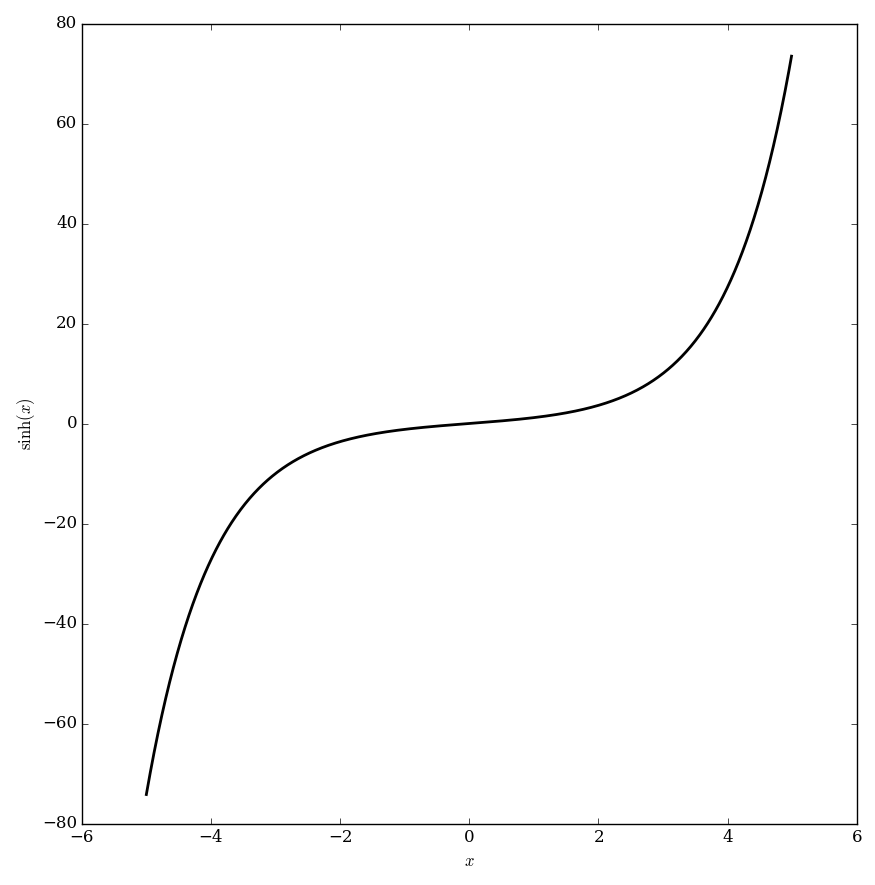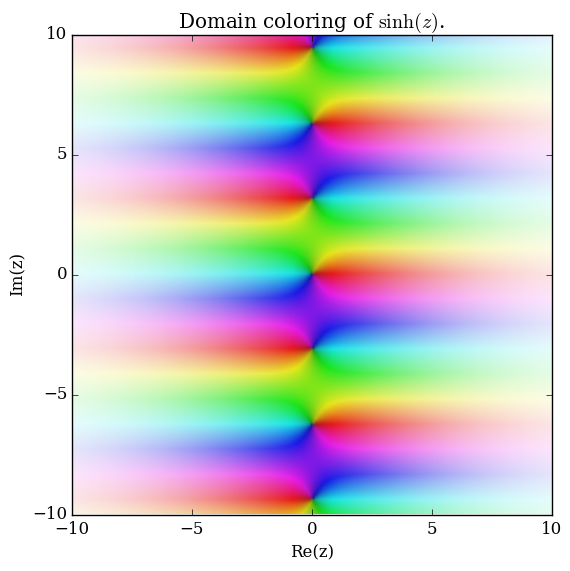Sinh
The hyperbolic sine function $\mathrm{sinh} \colon \mathbb{R} \rightarrow \mathbb{R}$ is defined by $$\mathrm{sinh}(z)=\dfrac{e^z-e^{-z}}{2}.$$ Since this function is one-to-one, its inverse function the inverse hyperbolic sine function is clear.
Domain coloring of $\sinh$.
Contents
- 1 Properties
- 1.1 Theorem
- 1.2 Proof
- 1.3 References
- 1.4 Theorem
- 1.5 Proof
- 1.6 References
- 1.7 Theorem
- 1.8 Proof
- 1.9 References
- 1.10 Theorem
- 1.11 Proof
- 1.12 References
- 1.13 Theorem
- 1.14 Proof
- 1.15 References
- 1.16 Theorem
- 1.17 Proof
- 1.18 References
- 1.19 Theorem
- 1.20 Proof
- 1.21 References
- 1.22 Theorem
- 1.23 Proof
- 1.24 References
- 1.25 Theorem
- 1.26 Proof
- 1.27 References
- 1.28 Theorem
- 1.29 Proof
- 1.30 References
- 2 See Also
Properties
Theorem
The following formula holds: $$\dfrac{\mathrm{d}}{\mathrm{d}z} \sinh(z) = \cosh(z),$$ where $\sinh$ denotes the hyperbolic sine and $\cosh$ denotes the hyperbolic cosine.
Proof
From the definition, $$\sinh(z) = \dfrac{e^z-e^{-z}}{2},$$ and so using the derivative of the exponential function, the linear property of the derivative, the chain rule, and the definition of the hyperbolic cosine, $$\dfrac{\mathrm{d}}{\mathrm{d}z} \sinh(z)=\dfrac{e^z + e^{-z}}{2}=\cosh(z),$$ as was to be shown. █
References
Theorem
The following formula holds: $$\cosh^2(z)-\sinh^2(z)=1,$$ where $\cosh$ denotes the hyperbolic cosine and $\sinh$ denotes the hyperbolic sine.
Proof
From the definitions $$\cosh(z)=\dfrac{e^{z}+e^{-z}}{2}$$ and $$\sinh(z)=\dfrac{e^{z}-e^{-z}}{2},$$ we see $$\begin{array}{ll} \cosh^2(z) - \sinh^2(z) &= \left( \dfrac{e^{z}+e^{-z}}{2} \right)^2 - \left( \dfrac{e^{z}-e^{-z}}{2} \right)^2 \\ &= \dfrac{1}{4} \left( e^{2z}+2+e^{-2z}-e^{2z}+2-e^{-2z} \right) \\ &= 1, \end{array}$$ as was to be shown. █
References
- 1964: Milton Abramowitz and Irene A. Stegun: Handbook of mathematical functions ... (previous) ... (next): $4.5.16$
Theorem
The following formula holds: $$\sinh(az)=az {}_0F_1 \left( ; \dfrac{3}{2} ; \dfrac{(az)^2}{4} \right),$$ where $\sinh$ denotes the hyperbolic sine and ${}_0F_1$ denotes the hypergeometric pFq.
Proof
References
Theorem
The Weierstrass factorization of $\sinh(x)$ is $$\sinh(x)=x\displaystyle\prod_{k=1}^{\infty} 1 + \dfrac{x^2}{k^2\pi^2}.$$
Proof
References
Theorem
The following Taylor series holds for all $z \in \mathbb{C}$: $$\sinh(z)=\displaystyle\sum_{k=0}^{\infty} \dfrac{z^{2k+1}}{(2k+1)!},$$ where $\sinh$ is the hyperbolic sine.
Proof
References
Theorem
The following formula holds: $$I_{\frac{1}{2}}(z)=\sqrt{\dfrac{2}{\pi z}}\sinh(z),$$ where $I_{\frac{1}{2}}$ denotes the modified Bessel function of the first kind and $\sinh$ denotes the hyperbolic sine.
Proof
References
Theorem
The following formula holds: $$\sin(z)=-i \sinh(iz),$$ where $\sin$ denotes the sine and $\sinh$ denotes the hyperbolic sine.
Proof
From the definition of $\sin$ and $\sinh$ and the reciprocal of i, $$-i\sinh(iz) = \dfrac{e^{iz}-e^{-iz}}{2i} =\sin(z),$$ as was to be shown.
References
Theorem
The following formula holds: $$\sinh(z)=-i\sin(iz),$$ where $\sinh$ is the hyperbolic sine and $\sin$ is the sine.
Proof
By definition, $$\sinh(z) = \dfrac{e^{z}-e^{-z}}{2},$$ and so by the definition of $\sin$ and the reciprocal of i, we see $$-i\sinh(iz)=\dfrac{e^{iz}-e^{-iz}}{2i},$$ as was to be shown. █
References
- 1964: Milton Abramowitz and Irene A. Stegun: Handbook of mathematical functions ... (previous) ... (next): $4.5.7$
Theorem
The following formula holds: $$\tan(\mathrm{gd}(x))=\sinh(x),$$ where $\tan$ denotes tangent, $\mathrm{gd}$ denotes the Gudermannian, and $\sinh$ denotes the hyperbolic sine.
Proof
References
Theorem
The following formula holds: $$\sinh(\mathrm{gd}^{-1}(x))=\tan(x),$$ where $\sinh$ is the hyperbolic sine, $\mathrm{gd}^{-1}$ is the inverse Gudermannian, and $\tan$ is the tangent.

